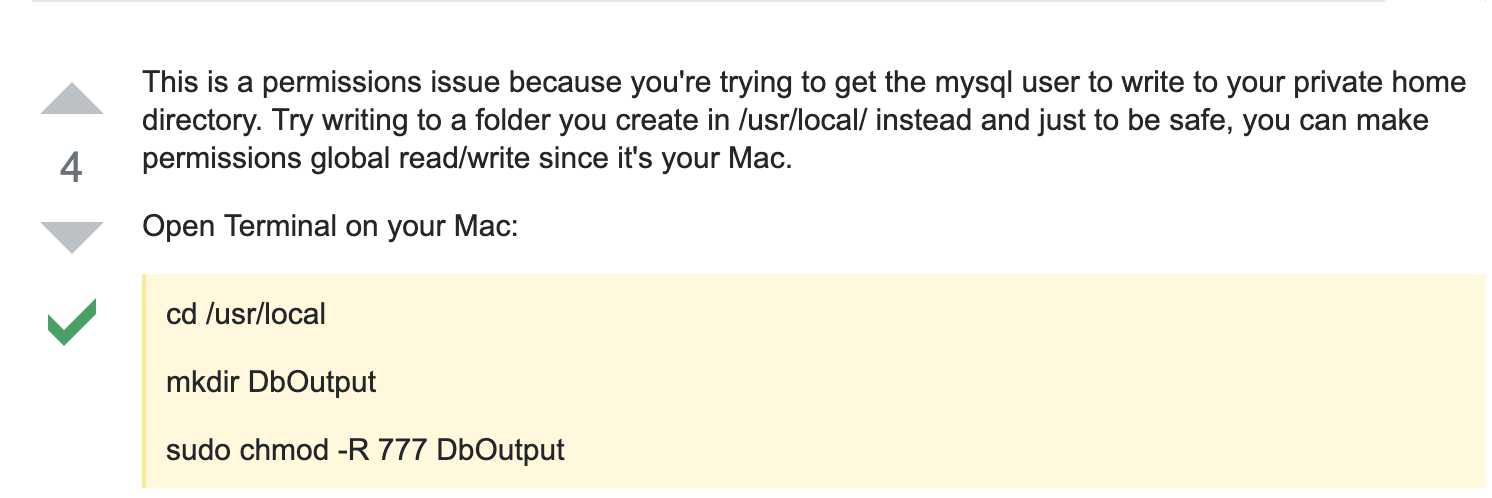总结关于Mac上使用MySQL一些常见的问题
Posted fuyusheng
tags:
篇首语:本文由小常识网(cha138.com)小编为大家整理,主要介绍了总结关于Mac上使用MySQL一些常见的问题相关的知识,希望对你有一定的参考价值。
Num 1. MySQL5.7导出数据时提示--secure-file-priv解决办法:
问题分析
在官方的文档中,对secure_file_priv进行了说明,它用于限制数据的导出。
- secure_file_priv 为 NULL 时,表示限制mysqld不允许导入或导出。
- secure_file_priv 为 /tmp 时,表示限制mysqld只能在/tmp目录中执行导入导出,其他目录不能执行。
- secure_file_priv 没有值时,表示不限制mysqld在任意目录的导入导出。
在Mysql中输入命令show variables like ‘%secure_file_priv%‘;可以看到默认secure_file_priv = NULL。
mysql> show global variables like ‘%secure_file_priv%‘;
+------------------+-------+
| Variable_name | Value |
+------------------+-------+
| secure_file_priv | NULL |
+------------------+-------+
解决办法
1. 检查support-files文件夹(路径 /usr/local/mysql/support-files 这是Mac中的隐藏文件夹,在Finder下shift+command+g然后输入路径),是否有my.cnf配置文件,在Mac中好像是默认不存在该文件(具体不清楚),需要我们自己手动配置Mysql。
2. (关闭Mysql)需要在 /etc下配置my.cnf,首先 cd /etc,然后手动配置,vim my.cnf,输入以下配置信息。
# Example MySQL config file for medium systems. # # This is for a system with little memory (32M - 64M) where MySQL plays # an important part, or systems up to 128M where MySQL is used together with # other programs (such as a web server) # # MySQL programs look for option files in a set of # locations which depend on the deployment platform. # You can copy this option file to one of those # locations. For information about these locations, see: # http://dev.mysql.com/doc/mysql/en/option-files.html # # In this file, you can use all long options that a program supports. # If you want to know which options a program supports, run the program # with the "--help" option. # The following options will be passed to all MySQL clients [client] default-character-set=utf8 #password = your_password port = 3306 socket = /tmp/mysql.sock # Here follows entries for some specific programs # The MySQL server [mysqld] character-set-server=utf8 init_connect=‘SET NAMES utf8 port = 3306 socket = /tmp/mysql.sock skip-external-locking key_buffer_size = 16M max_allowed_packet = 1M table_open_cache = 64 sort_buffer_size = 512K net_buffer_length = 8K read_buffer_size = 256K read_rnd_buffer_size = 512K myisam_sort_buffer_size = 8M character-set-server=utf8 init_connect=‘SET NAMES utf8‘ secure_file_priv= # Don‘t listen on a TCP/IP port at all. This can be a security enhancement, # if all processes that need to connect to mysqld run on the same host. # All interaction with mysqld must be made via Unix sockets or named pipes. # Note that using this option without enabling named pipes on Windows # (via the "enable-named-pipe" option) will render mysqld useless! # #skip-networking # Replication Master Server (default) # binary logging is required for replication log-bin=mysql-bin # binary logging format - mixed recommended binlog_format=mixed # required unique id between 1 and 2^32 - 1 # defaults to 1 if master-host is not set # but will not function as a master if omitted server-id = 1 # Replication Slave (comment out master section to use this) # # To configure this host as a replication slave, you can choose between # two methods : # # 1) Use the CHANGE MASTER TO command (fully described in our manual) - # the syntax is: # # CHANGE MASTER TO MASTER_HOST=<host>, MASTER_PORT=<port>, # MASTER_USER=<user>, MASTER_PASSWORD=<password> ; # # where you replace <host>, <user>, <password> by quoted strings and # <port> by the master‘s port number (3306 by default). # # Example: # # CHANGE MASTER TO MASTER_HOST=‘125.564.12.1‘, MASTER_PORT=3306, # MASTER_USER=‘joe‘, MASTER_PASSWORD=‘secret‘; # # OR # # 2) Set the variables below. However, in case you choose this method, then # start replication for the first time (even unsuccessfully, for example # if you mistyped the password in master-password and the slave fails to # connect), the slave will create a master.info file, and any later # change in this file to the variables‘ values below will be ignored and # overridden by the content of the master.info file, unless you shutdown # the slave server, delete master.info and restart the slaver server. # For that reason, you may want to leave the lines below untouched # (commented) and instead use CHANGE MASTER TO (see above) # # required unique id between 2 and 2^32 - 1 # (and different from the master) # defaults to 2 if master-host is set # but will not function as a slave if omitted #server-id = 2 # # The replication master for this slave - required #master-host = <hostname> # # The username the slave will use for authentication when connecting # to the master - required #master-user = <username> # # The password the slave will authenticate with when connecting to # the master - required #master-password = <password> # # The port the master is listening on. # optional - defaults to 3306 #master-port = <port> # # binary logging - not required for slaves, but recommended #log-bin=mysql-bin # Uncomment the following if you are using InnoDB tables #innodb_data_home_dir = /usr/local/mysql/data #innodb_data_file_path = ibdata1:10M:autoextend #innodb_log_group_home_dir = /usr/local/mysql/data # You can set .._buffer_pool_size up to 50 - 80 % # of RAM but beware of setting memory usage too high #innodb_buffer_pool_size = 16M #innodb_additional_mem_pool_size = 2M # Set .._log_file_size to 25 % of buffer pool size #innodb_log_file_size = 5M #innodb_log_buffer_size = 8M #innodb_flush_log_at_trx_commit = 1 #innodb_lock_wait_timeout = 50 [mysqldump] quick max_allowed_packet = 16M [mysql] no-auto-rehash # Remove the next comment character if you are not familiar with SQL #safe-updates default-character-set=utf8 [myisamchk] key_buffer_size = 20M sort_buffer_size = 20M read_buffer = 2M write_buffer = 2M [mysqlhotcopy] interactive-timeout
3. sudo chmod 644 my.cnf,将该配置文件的读写执行权限改为644。(推荐每次修改该配置文件后都重新设置644权限)
4. 打开Mysql,输入 show variables like ‘%secure_file_priv%‘;可以看到secure_file_priv = 空。
mysql> show variables like ‘%secure_file_priv%‘;
+------------------+-------+
| Variable_name | Value |
+------------------+-------+
| secure_file_priv | |
+------------------+-------+
1 row in set (0.00 sec)
Num2. MySQL导入数据显示“Error code:13. Can‘t get stat of ‘ ’(Permission denied)”解决办法:
解决办法:
在解决"secure-file-priv"问题后,导入数据时再次碰见错误。在google后找到解决办法。
将load data infile 改为 load data local infile。错误即可解决(具体原因不清楚)
Num3. MySQL导出数据显示“Can‘t create/write to file ‘Users/***’(Errcode:13)”解决办法:
问题分析:
这应该是关于MySQL临时文件目录的问题,为解决这个问题做了很多尝试,在my.cnf配置临时文件目录,并给予该文件777权限等等都没有解决问题。
解决办法:
最后同样在google上找到解决办法。如下图

这是由于权限问题,因为试图让mysql用户将数据写入私人主目录。我们可以在usr/local下创建一个文件夹,用来保存从mysql中导出的数据。
2019-06-30 18:03:14
以上是关于总结关于Mac上使用MySQL一些常见的问题的主要内容,如果未能解决你的问题,请参考以下文章